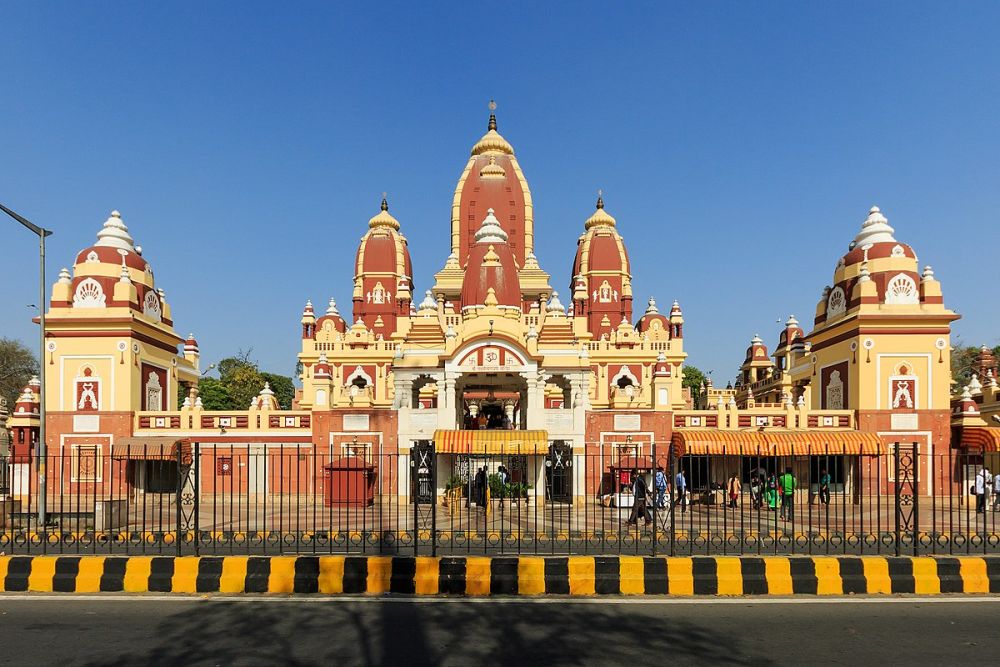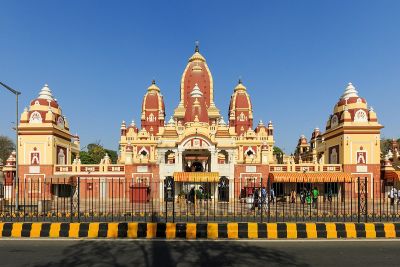

Embark on a serene journey through the grand Laxminarayan Temple, commonly known as Birla Mandir, one of Delhi's major landmarks. A knowledgeable guide will lead you through the intricacies of this magnificent temple, explaining the history and architecture of this marvel constructed by the industrialist B. R. Birla. The temple, dedicated to the god Vishnu and his consort, Lakshmi, offers a tranquil oasis in the heart of the bustling city. As you walk through the temple's large garden, you'll be exposed to the elaborate carvings, beautiful statues, and the stunning water fountains. The guide will also delve into the significance of the temple's rituals, the meanings behind the Hindu deities, and the importance of the temple in the socio-religious landscape of India.
Participate in the soul-stirring evening Aarti ceremony at the Laxminarayan Temple for a spiritual experience you're unlikely to forget. The Aarti is a Hindu religious ritual of worship, a part of puja, in which light from wicks soaked in ghee (purified butter) or camphor is offered to one or more deities. During the ceremony, chants and hymns fill the air, and devotees surrender to the divine rhythm and spirituality that the Temple is known for. Witnessing the Aarti provides a deeper understanding of the faith and is a chance to engage with the local community. The synchronization of bells, drums, and the chorus create a truly mesmerizing and profound ambiance.
For photography enthusiasts, the Laxminarayan Temple offers a canvas of vibrant culture, intricate architecture, and beautifully landscaped gardens that can make for some splendid shots. As you move around the premises, you can capture the ornate carvings on the walls, the serene expressions on the idols, and the various shades of the temple during different times of the day. The entrance archway, the majestic spires, and the floral motifs are particularly camera-friendly. Photography within the temple premises is allowed, but it's always best to be respectful and seek permission before photographing worshippers and certain interior areas of the temple.
Laxminarayan Temple is a hub of festivities during Hindu religious celebrations such as Janmashtami, Diwali, and Navaratri. These festivals are celebrated with great fervor, and the temple is decorated extravagantly. Visitors are welcome to partake in these celebrations, which often include special prayers, traditional music and dance performances, and free food distribution (known as 'prasad'). Witnessing and being part of these celebrations can be an incredible way to experience India's rich cultural heritage and religious tradition. Each festival has its unique significance and set of rituals, providing an insightful glance into the cultural mosaic of Indian society.
Seek out peace and tranquility by attending meditation sessions at the Laxminarayan Temple. The serene environment and the temple's spiritual aura provide the perfect backdrop for a meditative experience. Regular sessions are conducted by experienced practitioners who guide participants through various techniques of meditation, aimed at relaxation and spiritual growth. These silent, reflective practices allow you to detach from the material world and attain a state of inner calm. While the temple itself does not charge for such activities, special programs or sessions led by visiting experts might require an entry fee or a minimal donation.
The Laxminarayan Temple is not only a place of worship but also a valuable educational site that offers an immersive experience into Hindu culture and Vedic traditions. Schools and colleges can organize educational tours for students to learn about the architecture that encapsulates centuries of historical development and the religious stories that form the Hindu mythological canon. The guided tour often includes a visit to the museum section of the temple where religious artifacts are displayed. The educational tour can be a compelling addition to a student's learning curve, offering real-life insights into subjects like history, art, and religion.
In the peaceful precincts of the Laxminarayan Temple, individuals can immerse themselves in the ancient practice of Yoga. Periodically, the temple hosts yoga workshops or regular classes led by experienced instructors who help participants of all levels improve their physical postures, breathing techniques, and mental focus. Yoga sessions here are an opportunity to unite the body, mind, and spirit in a divine setting. Whether you are a beginner or an advanced practitioner, these workshops provide a supportive and inspirational setting to further your practice. Attendees should check in advance for scheduling and any potential fees to participate.
Occasionally, the Laxminarayan Temple serves as a venue for cultural performances, showcasing traditional Indian music, dance, and drama. These events promote and preserve India's diverse artistic legacy while providing temple visitors with an enriching cultural experience. Performances might feature classical Indian dance forms such as Bharatanatyam or Kathak, devotional music, or enactments of scenes from epic scriptures. These evenings can be a real treat for culture enthusiasts looking to experience the performing arts in a spiritually significant context. While most performances are open to the public, special events may require tickets or prior registration.
Visitors to Laxminarayan Temple can explore the on-site shops selling religious books, offering a wide range of literature on Hindu scriptures, philosophy, and history. Besides books, these shops often sell various souvenirs, including idols, jewelry, and other items related to Hindu mythology and spirituality. Purchasing from these shops is a thoughtful way to bring a piece of the temple's sanctity back home with you or to find gifts that carry a deeper meaning. It's also a means to support the temple, as proceeds from the sales typically contribute to the temple's maintenance and charitable activities.
The Laxminarayan Temple is not only a place of spiritual practice but also a center for social service. Volunteer opportunities are available for those who wish to give back to the community. This could include helping in the temple's kitchen, which serves food to the needy, assisting in maintaining the cleanliness of the temple premises, or participating in educational programs run by the temple's trust. Engaging in such activities can be deeply rewarding and offers a way to connect with the local community while practicing the tenet of 'seva' or selfless service.
